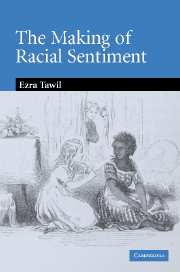Book contents
- Frontmatter
- Contents
- Acknowledgments
- Introduction: Toward a literary history of racial sentiment
- 1 The politics of slavery and the discourse of race, 1787–1840
- 2 Remaking natural rights: race and slavery in James Fenimore Cooper's early writings
- 3 Domestic frontier romance, or, how the sentimental heroine became white
- 4 “Homely legends”: the uses of sentiment in Cooper's The Wept of Wish-Ton-Wish
- 5 Stowe's vanishing Americans: “negro” interiority, captivity, and homecoming in Uncle Tom's Cabin
- Conclusion: Captain Babo's cabin: racial sentiment and the politics of misreading in Benito Cereno
- Notes
- Index
Introduction: Toward a literary history of racial sentiment
Published online by Cambridge University Press: 22 September 2009
- Frontmatter
- Contents
- Acknowledgments
- Introduction: Toward a literary history of racial sentiment
- 1 The politics of slavery and the discourse of race, 1787–1840
- 2 Remaking natural rights: race and slavery in James Fenimore Cooper's early writings
- 3 Domestic frontier romance, or, how the sentimental heroine became white
- 4 “Homely legends”: the uses of sentiment in Cooper's The Wept of Wish-Ton-Wish
- 5 Stowe's vanishing Americans: “negro” interiority, captivity, and homecoming in Uncle Tom's Cabin
- Conclusion: Captain Babo's cabin: racial sentiment and the politics of misreading in Benito Cereno
- Notes
- Index
Summary
While we know that racial theories have been built on and engendered a range of “scientific” subdisciplines – from Lamarckianism to Social Darwinism, eugenics, degeneracy theory, anthropology, philology, and social psychology – we have not really interrogated the epistemic principles, the ways of knowing – on which racisms rely. Folk and scientific theories of race have rarely, if ever, been about somatics alone. What is so striking as we turn to look at the epistemic principles that shaped nineteenth-century enquiries into race and sexuality is that both were founded on criteria for truth that addressed invisible coordinates of race by appealing to both visual and verbal forms of knowledge at the same time … Racism is not only a “visual ideology” where the visible and somatic confirms the “truth” of the self. Euro-American racial thinking related the visible markers of race to the protean hidden properties of different human kinds. Nineteenth-century bourgeois orders were predicated on these forms of knowledge that linked the visible, physiological attributes of national, class, and sexual Others to what was secreted in their depths – and none of these could be known without also designating the psychological dispositions and sensibilities that defined who and what was echte European.
It is this combined palpability and intangibility that makes race slip through reason and rationality.
Ann Laura Stoler, Race and the Education of DesireThere is an important sense, then, in which the question of the color line – Are you white or black? – cannot be answered by an appeal to color.
Walter Benn Michaels, “The Souls of White Folk”- Type
- Chapter
- Information
- The Making of Racial SentimentSlavery and the Birth of The Frontier Romance, pp. 1 - 25Publisher: Cambridge University PressPrint publication year: 2006



